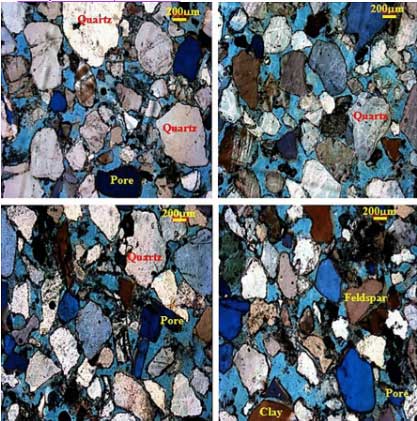Monitor - ISSN 1472-0221
The Newsletter for Data Acquisition and Control
Issue 282 May 2022
Welcome to Monitor, thanks for subscribing. This month, what is the effect of storing C02 in rocks under the sea?
You can download a pdf copy of the newsletter here.
Contents
* What is the effect of storing C02 in rocks under the sea?
* Reading from a pH Meter
* Data Acquisition News Round-Up
What is the effect of storing C02 in rocks under the sea?
Web link: https://www.windmill.co.uk/co2-storage.html
To help combat the climate crisis, CO2 is being pumped deep below the sea into depleted oil fields. There it becomes trapped in pores in the rock and dissolves into brine also trapped within the rocks.
Knowing how this process changes the pore structure and strength of the rocks is critical to effectively storing the carbon, and engineers in Scotland are using a Windmill data acquisition system to help them with this research.
Led by Peter Ameh of the University of Edinburgh and Abubakar Tafawa Balewa University, Nigeria, the researchers obtained five sandstone samples from around 1640 m down in a potential CO2 storage site in Scotland. They measured their samples' weights, volumes, porosity and strain behaviour before and after saturating them with various phaseCO2-brine.

The team used a Microlink 751 multifunction data acquisition and control unit. They ran Windmill Software to set the Microlink at 15-bits per channel with a 0-10 V dc range and a precision of 0.05%. The Microlink records the displacement data from a LVDT (linear variable differential transducer). The Windmill software displays data as it is collected.
The Microlink can measure temperature, strain, pressure, voltage and current through 16 analogue input channels. It can switch up to 32 digital outputs and monitor up to 32 digital inputs. It can also count events with up to 8 counters. You can connect eight Microlinks to one PC giving 128 analogue inputs and 256 digital inputs and outputs. Use Windmill software to choose from four analogue input ranges or automatic ranging to let the software match the input signal as closely as possible. You can also use Windmill to select the resolution from 7 options: choose high throughput or high resolution.
The researchers say that the result of this work is useful for predicting the change in the geometry of pores and the strain of saline reservoir rocks in planned and existing giant CO2 sites.
Further Reading Peter, A., Jin, X., Fan, X. et al. Effect of CO2 Phase on Pore Geometry of Saline Reservoir Rock. Rock Mech Rock Eng 55, 1907-1930 (2022). https://doi.org/10.1007/s00603-021-02658-x
Microlink 751: Multi-Function Data Acquisition and Control, Windmill Software Limited
Your Data Acquisition Questions Answered: Reading from a pH Meter
Question
"I am looking for Software to record pH data from a Fisherbrand Accumet XL150 pH meter. Are you able to help with this?".
Answer
Yes. You can use the Windmill Software to talk to the Accumet XL150, using either an RS232 or ethernet connection. You will need to know (from the Accumet documentation) the message structure and communication settings (baud rate etc for RS232, ip address and port for ethernet).
Subscribers to this Monitor newsletter can download a free copy of the full suite of Windmill software - email monitor@windmillsoft.com for details.
More Information
pH Serial Communication and Data Logging Software
Measurements from pH probes via Ethernet or Internet - Microlink 851-pH: pH data logger with digital I/O and counting.
Welcome to our round-up of the data acquisition and control news. If you would like to receive more timely DAQ news updates then follow us on Twitter - @DataAcquisition - or grab our rss feed. Sapphire fibre sensor could lead to cleaner air travel
Researchers have developed a sensor made from sapphire fibre with the ability to withstand extreme temperatures. The technology has the potential to enable significant improvements in terms of operational efficiency and emissions reduction
Sweater includes a wireless charger to keep your gadgets topped up
A sweater containing tubes filled with a liquid metal alloy can charge up wearable electronic devices
Low cost shoe insoles monitor gait
Researchers have developed a low-cost shoe insole, equipped with force-sensitive resistors to improve the management of health conditions that impair mobility, such as stroke, Parkinson's disease and osteoarthritis.
A mission to monitor migrating monarchs
Tiny sensor tracks the migratory patterns of monarch butterflies
Sea ice tracked with fibre-optic sensors
Researchers are using a telecommunications fibre-optic-based sensing system to track the spread of sea ice in near-real-time
Ship uses molten salt reactor for clean power
Norwegian company Ulstein have launched a ship powered by a Thorium Molten Salt Reactor (MSR) to generate vast amounts of clean, safe electricity. This enables the vessel to operate as a mobile power/charging station for a new breed of battery driven cruise ships.
DAQ News Round-up
Source: University of Oxford
https://www.ox.ac.uk/
Source: New Scientist
https://www.newscientist.com/
Source: University of Massachutts Amherst
https://www.cics.umass.edu/
Source: The Engineer
https://news.engineering.pitt.edu/
Source: The Engineer
https://www.theengineer.co.uk/
Source: SCUBA News
https://news.scubatravel.co.uk/
Subscribe to Monitor